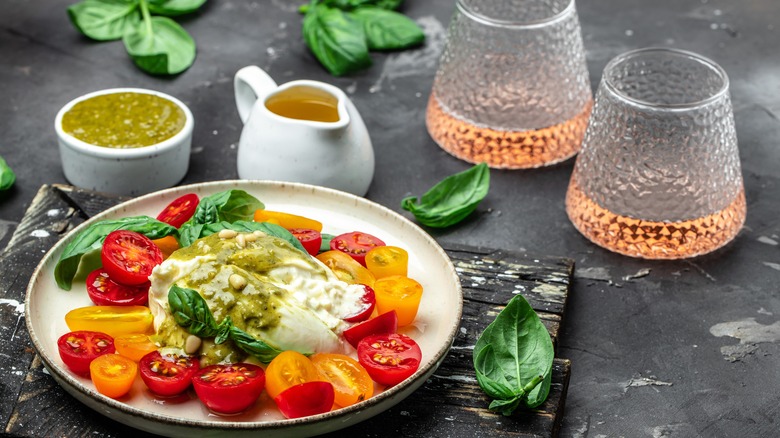Why Dry Rosé Is A Fail-Proof Option For Cheese Pairings
When you're putting together a cheese board or making a dish like cheese fondue, the question of which wine to serve it with can be overwhelming. An option you may be overlooking is dry — meaning not sweet — rosé wine. This sometimes-underrated family of wines can be made by combining red and white grapes, though it is more common to make rosé by pressing red grapes, but limiting the amount of time the wine spends in contact with the grape skins. The rich color of red wine comes from the skins of the grapes, not the juice, and less contact results in pretty, pink-hued wines.
Rosé can play a sort of jack-of-all-trades role when it comes to ingredient pairings. A bottle may have a fruity roundness characteristic of red wines, but also that zippy, acidic quality that makes many white wines so refreshing. Rosés can have a wide variety of tasting notes, ranging from savory, herbal, peppery, and smoky to fresh and fruity, salty, and floral.
Food Republic spoke to Chad Galer, Vice President of Product Innovation and Food Safety at Dairy Management Inc., to get his opinion on which cheeses pair the best with rosé. He cited the mild flavor, light body, and acidity of rosé as reasons why it pairs well with many cheeses. He especially likes pairing dry rosé with saline, fresh-tasting cheeses, like Brie, burrata, and feta. Depending on the cheese, rosé can act as a palate cleanser, a contrasting taste, or a complementary flavor.
Why rosé pairs well with Brie, burrata, and feta
Chad Galer loves how "Brie's milky, salty and earthy flavor makes a great partner to the bright and tart flavors of dry rosé." This wine can cleanse the palate between bites of triple-creme Brie, so you can enjoy the cheese without feeling overwhelmed by its fatty richness. An earthy, crisp, and acidic pinot noir rosé from Sancerre, France would be lovely, as would a sparkling Cremant d'Alsace made from the same type of grapes.
Burrata, which is like a ball of fresh mozzarella with a flowing center, takes creaminess to the max. It has the perfect blend of sweet cream flavors and salt. A rosé with notes of tart fruit provides a necessary contrast, according to Galer. Try an Italian Sangiovese Rosato for its notes of bright red fruits, or a tart, dry, and bubbly Lambrusco Rosato Secco. A glass of pink wine, an heirloom caprese salad with burrata, and a seat on the patio would make for the perfect warm weather treat.
Pairing an acidic rosé with tangy feta cheese makes the two "more flavorful together," says Galer. Try pairing Greek feta with a Greek rosé made from dry and acidic agiorgitiko grapes. A rosé from Provence, France made from any combination of grenache, cinsault, syrah, and mourvèdre grapes would also be wonderful for its delectable minerality and fruity qualities. Think of notes like salted watermelon and fresh strawberries — a perfect booster to tangy and bright feta.


